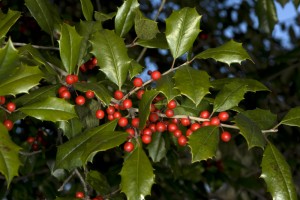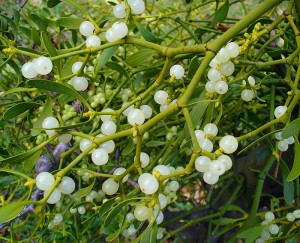Holiday Plants: A Two-Sided Coin
Posted in Uncategorized on December 25 2011, by Matt Newman
 After putting together my story on poinsettia the other day, I realized that there’s more to seasonal decor than a few colorful leaves. There are quite obviously berries, too–red and white–and boughs of pine woven into wreaths and garland. Of course there’s the classic Christmas tree. Frankincense, myrrh. Growing things have made their way into every nook and cranny of this decidedly green and red season.
After putting together my story on poinsettia the other day, I realized that there’s more to seasonal decor than a few colorful leaves. There are quite obviously berries, too–red and white–and boughs of pine woven into wreaths and garland. Of course there’s the classic Christmas tree. Frankincense, myrrh. Growing things have made their way into every nook and cranny of this decidedly green and red season.
But as with every decoration, every tradition, there’s a backstory to be dug up. I decided to tackle a few of these plants topically with the “poinsettia treatment,” and came up with some interesting results.
Its bright red berries and evergreen leaves make holly a favorite around Christmas. For most, it’s the source of lively sprigs meant to be hung as decoration or added as accents to a table centerpiece; we pin them to our wreaths. But holly’s not so welcome a character elsewhere. Ask one of the many forest volunteers around Seattle what they think of the cheerful red berry and you’ll get a mixed muttering of expletives and a showing of battle scars.
Celtic Druids once regarded holly as a symbol of good luck due to its resilience in winter, a fondness later adopted and redefined by the Christians (as happened with the iconic pine tree we so love to ring with tinsel and lights). But while the Druids warned that bad luck would come to any and all who dared chop down a holly tree, to those in the American northwest a little karmic misfortune is worth clearing these invasive pests out. Around Seattle and elsewhere in the country, English holly crowds out native trees by competing for resources. And dealing with the drudgery of removing it from northwestern forests each year is a miserable exercise in scratches and pinpricks. Most of the people behind the clean-up process will tell you that if you buy real holly for your Christmas decorations, you should be sure to throw it in the trash when the time comes–composting it will merely spread the berries around as birds peck them out of the pile.
 The same goes for our dear friend the mistletoe, hung from the doorway in years gone by in hopes of snagging kisses. But its downward trend in popularity over the last few years is welcome news to some in the horticulture industry. Not only are certain types of mistletoe poisonous if you eat them (thanks, Batman Returns), but they can also make for unwelcome parasites. The mistletoe often grows high up in trees, attaching itself to branches and stunting growth by pulling water and nutrients from the host via sap–frankly speaking, it’s a bloodsucker; it can outright kill trees in cases of heavy infestation. It’s also difficult to remove, seeing as it regularly grows well out of reach. In response, some have even taken to shooting the interloper out of the branches.
The same goes for our dear friend the mistletoe, hung from the doorway in years gone by in hopes of snagging kisses. But its downward trend in popularity over the last few years is welcome news to some in the horticulture industry. Not only are certain types of mistletoe poisonous if you eat them (thanks, Batman Returns), but they can also make for unwelcome parasites. The mistletoe often grows high up in trees, attaching itself to branches and stunting growth by pulling water and nutrients from the host via sap–frankly speaking, it’s a bloodsucker; it can outright kill trees in cases of heavy infestation. It’s also difficult to remove, seeing as it regularly grows well out of reach. In response, some have even taken to shooting the interloper out of the branches.
But there are two sides to mistletoe’s coin. In some spots, such as stands of juniper, the presence of mistletoe has actually been found to increase the number of juniper trees by attracting a great variety of feathered friends. As the birds come to feed on the mistletoe berries and nest in their dense knots of leaves, they also eat the juniper berries. The resulting propagation means more trees, more mistletoe, and more birds, leading to a beneficial relationship in some situations.
Still, if you happen to find yourself with a sprig of mistletoe ripe with white berries, do your community a favor and dispose of it properly. In fact, it should probably be the default decision whenever we decide to festoon our homes with the foliage of the season.
Better safe than sorry, right?

